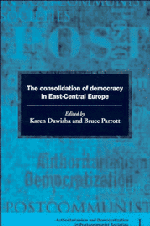Book contents
- Frontmatter
- Contents
- List of tables
- List of contributors
- Preface
- 1 Perspectives on postcommunist democratization
- 2 Democratization and political participation: research concepts and methodologies
- 3 Democratic consolidation in Poland after 1989
- 4 Party politics and political participation in postcommunist Hungary
- 5 Democratization and political participation: the experience of the Czech Republic
- 6 Democratization and political participation in Slovakia
- 7 Democratization and political participation in postcommunist societies: the case of Latvia
- 8 Democratization in Lithuania
- 9 Democratization and political development in Estonia, 1987–96
- Appendix
- Index
6 - Democratization and political participation in Slovakia
Published online by Cambridge University Press: 01 June 2011
- Frontmatter
- Contents
- List of tables
- List of contributors
- Preface
- 1 Perspectives on postcommunist democratization
- 2 Democratization and political participation: research concepts and methodologies
- 3 Democratic consolidation in Poland after 1989
- 4 Party politics and political participation in postcommunist Hungary
- 5 Democratization and political participation: the experience of the Czech Republic
- 6 Democratization and political participation in Slovakia
- 7 Democratization and political participation in postcommunist societies: the case of Latvia
- 8 Democratization in Lithuania
- 9 Democratization and political development in Estonia, 1987–96
- Appendix
- Index
Summary
In November 1989, citizens of Slovakia joined those in the Czech Lands in mass demonstrations that brought about the rapid end of one of Central and Eastern Europe's most oppressive communist regimes. With the end of the Communist Party's monopoly of political power, political life in Slovakia changed radically. The proliferation of groups and voluntary associations that followed was paralleled by the rapid repluralization of the party system in Slovakia as in the Czech Lands.
By the June 1992 elections, it was clear to most observers that the Czechoslovak federation would not last. In January 1993, the federation was replaced by independent Slovak and Czech states. In the Czech Lands, developments in both the political and economic realms continued to progress smoothly. Under the leadership of Prime Minister Václav Klaus, Czech political leaders continued their rapid reintroduction of a market economy. Czech political institutions also appeared to be more stable than those in most other postcommunist states.
In Slovakia, where political life differed in many important respects from trends in the Czech Republic prior to the break-up of the federation and where the shift to the market caused far greater economic hardship, political life after independence was more tumultuous. In contrast to the situation in the Czech Lands, where public support for Václav Klaus and the move to the market remained high, Slovak politics continued to be characterized by high levels of conflict among political leaders.
- Type
- Chapter
- Information
- The Consolidation of Democracy in East-Central Europe , pp. 197 - 244Publisher: Cambridge University PressPrint publication year: 1997
- 14
- Cited by



